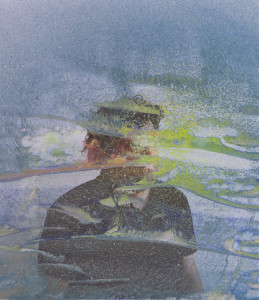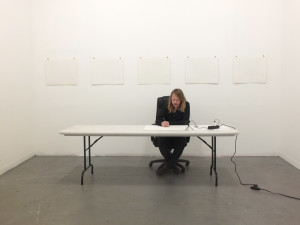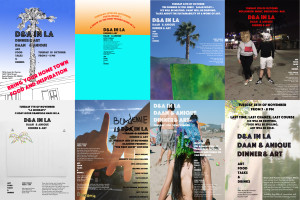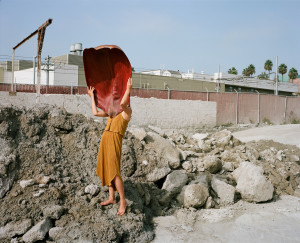Cement City
Anique Weve studied at the St. Joost and the Rietveld Academy. Her body of work consists of photography (including series of studio and portrait photographs, film) on the one hand and installations and interventions on the other. One of the most important themes in her work is intimacy. Together with Daan den Houter, she stayed for a residency in Los Angeles at the end of 2017. Daan den Houter is a multidisciplinary artist living and working in Rotterdam. Before attending art school, he studied Artificial Intelligence in which he found the basis for his work as an artist. His works investigate the way we adapt and look at the (art) world and focuses on generating changes on the most common, everyday things.

I spent the last three months of last year working with my friend Daan den Houter in America, doing research and getting inspired. As is probably the case with many artists, it was a long-held wish for us to be able to focus on our work for three months, without the hassle of side jobs, making money and social structures.
 For some time I had been walking around with an idea for new work in my head for which I wanted to go to America: a photo series about fate. Destiny, the romance of things we are sure of and things we are not in control of. I try to create a poetic voice against the images and influences of everyday life. In my mind, America would be the ideal starting point and inspiration par excellence for this photo series. It is the country, where people say you can make dreams come true, The American Dream. It's the country where people think the world is makeable, and that you can influence it.
For some time I had been walking around with an idea for new work in my head for which I wanted to go to America: a photo series about fate. Destiny, the romance of things we are sure of and things we are not in control of. I try to create a poetic voice against the images and influences of everyday life. In my mind, America would be the ideal starting point and inspiration par excellence for this photo series. It is the country, where people say you can make dreams come true, The American Dream. It's the country where people think the world is makeable, and that you can influence it.
In early 2016, Daan had an exhibition in Los Angeles. This was so successful that in the two weeks he stayed there, he was able to teach and arrange another exhibition, so he went there again in the summer of that year. What initially excited Daan about Los Angeles was that everything there is literally very big. Los Angeles is a metropolis the size of two-thirds of the Netherlands. This size also brings with it a different way of thinking. The city is big, so the spaces of galleries and museums are too, which in turn makes the artists think differently and literally create big work as well. Everything feels like art is taken more seriously, or there is more money involved in the art world. Such a big city also gives the feeling that there is a lot to do and that there are many opportunities and things to discover.
 From that summer in 2016, we started making plans together and we were accepted into the residency 18th Street Art Center. Through a sponsorship campaign we set up and a travel contribution from CBK Rotterdam, we were able to make it possible to go to Los Angeles for an extended period of time. Each with his own work and idea.
From that summer in 2016, we started making plans together and we were accepted into the residency 18th Street Art Center. Through a sponsorship campaign we set up and a travel contribution from CBK Rotterdam, we were able to make it possible to go to Los Angeles for an extended period of time. Each with his own work and idea.
In October and November 2017, we stayed at 18th Street Art Center in Santa Monica Los Angeles. We had a cottage with a separate studio on a property with several studios for local artists and three more studios for residents. These were occupied on a different schedule than our own stay, so we met many different residents; artists including from Poland, Taiwan, Vietnam, Australia and Germany (Cologne). You wouldn't say it by the size of Los Angeles, but 18th Street Art Center and another place are currently the only artist-in-residence spots in Los Angeles. For that reason alone, Los Angeles is a unique place to stay.
I didn't expect to experience another culture shock, much less think that it could happen in a Western country like the United States of America. But the first month certainly confronted me with the fact that I am European. Inspired by Daan's enthusiasm for L.A. and thinking of my own abilities, I expected to find the city very cool right away and to get through and under control more quickly. But I still needed a month, and eventually a car, for that.
Los Angeles is a very inward looking city. Everything is low-rise and very industrial, cycling is not possible everywhere and car drivers certainly don't take cyclists into account. There is public transport, but there are not always good connections and - again - L.A. is big so it often takes a long time to get somewhere. If you walk everything - the Americans find it strange - you are often the only one on the street. It really is a car city, everyone is inside with their air conditioning or in their air-conditioned cars, you drive from place to place even though the next place is at the end of the street. The streets are flooded with text and advertising, but not with the names of the companies that are actually in the building. When Daan and I rented a car everything changed. The city became small all at once, we pulled open doors and discovered a whole new world behind the facades. A wise lesson: "When in Los Angeles do as the Los Angelesers do."
We both had our own work plans, but decided to make a presentation every Tuesday night in our studio of the works we were working on at that time. This was accompanied by an open dinner. The first few Tuesdays were mostly a good start for getting in touch with the other residents. After that, attendance grew, with a fresh mix of new guests each week ranging from artists we had met, curators, or people who had found us through the web.
In this way we kept ourselves on our toes and were motivated to put up a new presentation of our work every week and thus to create a lot of new work. What was too crazy was that our plan worked, people had warned us that as an outsider it would be difficult to get people interested in your work, but because of the Tuesday nights we immediately got our own place and identity within the world of L.A. and different curators and gallery owners came to look at our work, even outside of Tuesdays.
 Every Monday Daan made an 8-hour drawing; a drawing in which he spent exactly one hour on each line of about 40cm. A drawing that symbolizes a western working day and simultaneously and literally converts eight hours of his life into eight lines. The series ultimately consists of seven drawings that were presented in an online group show via DENK gallery in Los Angeles, among other places. Besides various experiments, in the studio Daan was mainly concerned with the different possibilities and versions of ice paintings. The different ways of processing the colors and the combination on its own or captured on paper, produced interesting images and moments. Well received by the various visitors; a painting that changes in shape and color while you look at it, makes sound and slowly dissolves into a memory.
Every Monday Daan made an 8-hour drawing; a drawing in which he spent exactly one hour on each line of about 40cm. A drawing that symbolizes a western working day and simultaneously and literally converts eight hours of his life into eight lines. The series ultimately consists of seven drawings that were presented in an online group show via DENK gallery in Los Angeles, among other places. Besides various experiments, in the studio Daan was mainly concerned with the different possibilities and versions of ice paintings. The different ways of processing the colors and the combination on its own or captured on paper, produced interesting images and moments. Well received by the various visitors; a painting that changes in shape and color while you look at it, makes sound and slowly dissolves into a memory.
At the beginning of a residency you are always handicapped because you can never bring all your materials and your tools. The culture and size is different and you have to reinvent a lot of things. For example, our studio in Los Angeles had no daylight, which I always use in my work. This caused me to shoot outside the studio and step away from just the classic portraits I normally shoot. In addition, the light in L.A. was much brighter and harsher which also made me explore the effect of shadow as an extra dimension, a new layer over my photography.
 We had figured that after two months of hard work, presentations and research in Los Angeles we would spend the last four weeks traveling through southwest America, to surround ourselves with and be inspired by American nature in that way as well. The country is big, we have a kind of desert tour done where every 100 kilometers the landscape changed: the composition of the mountains and plants and especially the colors. You realize that the land really has to be conquered, and that it is very present. There is a lot of space, but that space is also very empty or 'unusable'; dry and barren or high and steep. The landscape calls for adventure and at the same time the impassability of 'mother nature' becomes visible. One of the highlights of this trip was Marfa Texas. In Marfa Donald Judd bought a large military base to place several permanent art installations there. Very inspiring, and special because at the time we were there there was 10cm of snow - something that almost doesn't happen there. Another highlight was Roswell, where we visited two retrospective exhibitions of '50 years of the Roswell artist-in-residence program', a privately initiated program by Mr. Donald B. Anderson, where each year six artists live and work for a year. Then Santa Fe with the museum about Georgia O'Keeffe, Mesa Verda (Indian houses in the rocks), the Grand Canyon, Zion Park and last but not least we are at the (landart) work Double Negative by Michael Heizer. A work of art somewhere on a plain in the middle of the desert to which we coordinated ourselves via small rocky roads. A highlight, despite the fact that the work actually consists of 'nothing'.
We had figured that after two months of hard work, presentations and research in Los Angeles we would spend the last four weeks traveling through southwest America, to surround ourselves with and be inspired by American nature in that way as well. The country is big, we have a kind of desert tour done where every 100 kilometers the landscape changed: the composition of the mountains and plants and especially the colors. You realize that the land really has to be conquered, and that it is very present. There is a lot of space, but that space is also very empty or 'unusable'; dry and barren or high and steep. The landscape calls for adventure and at the same time the impassability of 'mother nature' becomes visible. One of the highlights of this trip was Marfa Texas. In Marfa Donald Judd bought a large military base to place several permanent art installations there. Very inspiring, and special because at the time we were there there was 10cm of snow - something that almost doesn't happen there. Another highlight was Roswell, where we visited two retrospective exhibitions of '50 years of the Roswell artist-in-residence program', a privately initiated program by Mr. Donald B. Anderson, where each year six artists live and work for a year. Then Santa Fe with the museum about Georgia O'Keeffe, Mesa Verda (Indian houses in the rocks), the Grand Canyon, Zion Park and last but not least we are at the (landart) work Double Negative by Michael Heizer. A work of art somewhere on a plain in the middle of the desert to which we coordinated ourselves via small rocky roads. A highlight, despite the fact that the work actually consists of 'nothing'.
In summary, this work period in Los Angeles and The South-West has brought us a lot; new connections, friends, inspiration and insights. It's nice to be back, to be able to really reflect on what we've all been through and incorporate everything into even more new work. Traveling and being pulled outside of my normal life and studio has brought a lot to my work and tastes like more. So I say, "The wild west isn't gone from me yet, on to the next destination!"


